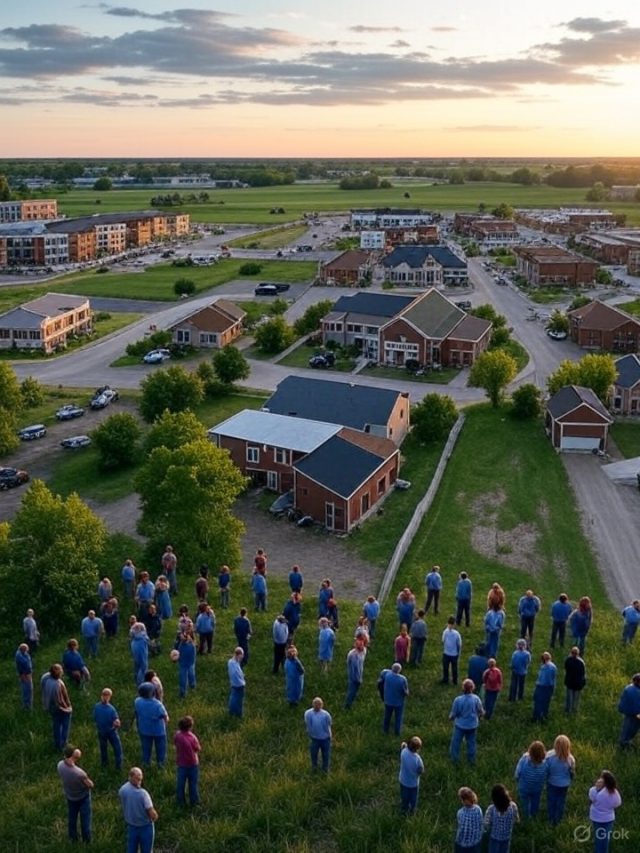
Circleville – Our communities are growing, and it’s not just a few families here and there but by the thousands of new homes. Those homes are growing up all over Pickaway County, from Commercial Point to South Bloomfield, Ashville, and Circleville. Circleville is currently in the middle of an almost 1,500 new home boom. Some housing developments have already started, and some are on the table pending approval. South Bloomfield just approved around 150 new homes, and Commercial Point has been growing for the last several years. I took a moment and zoomed out to see how other growing communities across the US are dealing with growth and weighing the pros and cons.
Across small towns and underdeveloped counties, the arrival of new housing developments, commercial complexes, and industrial projects is reshaping the landscape—literally and figuratively. As farmland gives way to subdivisions and strip malls, residents and local leaders grapple with the promise and peril of growth. While development brings economic opportunities and modern amenities, it also threatens the quiet, rural charm that defines these communities. From bustling townships to sleepy villages, the debate over development is heating up.
The Pros of Development
Economic growth is often the loudest argument in favor of development. New businesses, from retail chains to small startups, create jobs that keep local dollars circulating. In Jefferson Township, Ohio, the construction of a logistics hub last year brought 200 jobs to an area where unemployment hovered above 8%. “The warehouse gave my son a steady paycheck without him leaving town,” said Maria Thompson, a lifelong resident. Tax revenues from such projects also fund schools, infrastructure, and public services, easing the burden on cash-strapped municipalities. (Pickaway County is at 4.7%)
Housing developments address another pressing need: affordable homes. In counties like Franklin, Virginia, population growth has outpaced housing stock, driving up prices. New subdivisions offer options for young families and retirees alike, preventing outmigration to urban centers. “We were losing our kids to the cities,” said Franklin County Supervisor Ellen Carter. “Now, they can stay and build a life here.” (Median Price of Homes in Pickaway County is $330,000)
For small cities like Jasper, Indiana, development means modern amenities. A new shopping center with a grocery chain and coffee shops has reduced the need for residents to drive 30 miles for basics. Enhanced broadband access, often bundled with commercial projects, also connects rural areas to the digital economy, enabling remote work and online education.
The Cons of Development
Yet, the transformation of farmland into concrete sprawls comes at a cost. The loss of agricultural land threatens local food systems and the rural identity cherished by residents. In Lancaster County, Pennsylvania, where Amish farms dot the landscape, a proposed 500-unit housing project has sparked protests. “This land has fed families for generations,” said farmer Jacob Lapp. “Once it’s gone, it’s gone forever.”
Increased traffic and noise disrupt the tranquility that defines small-town life. In the village of Caledonia, New York, residents report that a new industrial park has doubled commute times on once-quiet roads. Environmental concerns also loom large. Runoff from construction sites can pollute local waterways, and sprawling developments strain water and sewer systems not designed for rapid growth.
Property taxes often rise as land values increase, squeezing longtime residents on fixed incomes. In rural Georgia’s Greene County, retirees like Susan Miller face tough choices. “My taxes went up 30% after the new golf resort came in,” she said. “I might have to sell the home I’ve lived in for 40 years.”
Benefits for Local Governments
For townships, villages, and small cities, development can be a lifeline. Increased tax revenue strengthens budgets, allowing investments in crumbling infrastructure or underfunded schools. In the township of Plainfield, Illinois, a mixed-use development funded a new fire station, cutting emergency response times by half. Grants tied to development projects also help small municipalities modernize utilities or expand public spaces like parks.
Commercial growth diversifies local economies, reducing reliance on volatile agricultural markets. Villages like Elkhorn, Wisconsin, have leveraged retail developments to attract tourists, boosting local businesses. “Our downtown was dying,” said Mayor Tom Bradley. “Now, we’ve got restaurants and shops thriving because of the new visitors.”
Challenges for Local Governments
However, managing growth is no small feat. Small-town officials often lack the expertise to negotiate with savvy developers, leading to deals that favor corporations over communities. In some cases, tax incentives offered to attract businesses strain budgets when promised economic benefits fall short. “We gave a developer a 10-year tax break, but the jobs were mostly low-wage,” lamented a councilmember in rural Tennessee.
Infrastructure strain is another hurdle. Many rural areas rely on outdated water, sewer, and road systems ill-equipped for rapid growth. Upgrading these systems requires significant investment, often beyond the means of small governments. Zoning disputes also spark conflict, as residents push back against projects that clash with community values or aesthetics.
Perhaps the biggest challenge is balancing growth with preservation. Local leaders must navigate vocal opposition from residents who fear losing their way of life. Public hearings in places like York County, Maine, have turned heated as farmers and newcomers clash over proposed developments. “We want progress, but not at the expense of who we are,” said resident Sarah Holmes.
Striking a Balance
As development reshapes rural America, communities face a delicate balancing act. Thoughtful planning can maximize benefits while minimizing harm. Tools like impact fees ensure developers contribute to infrastructure costs, while conservation easements protect farmland from encroaching sprawl. Community engagement—through town halls or visioning sessions—helps align projects with local values.
In some areas, innovative solutions are emerging. The village of Middlefield, Ohio, partnered with a developer to create a “green” subdivision with preserved green spaces and energy-efficient homes, blending growth with environmental stewardship. Other towns are adopting “smart growth” policies, focusing development in existing urban cores to spare rural landscapes.
Looking Ahead
The debate over development in small towns and counties is unlikely to fade. For every resident cheering new jobs or a nearby Starbucks, another mourns the loss of open fields and starry nights. Local governments, caught in the middle, must weigh short-term gains against long-term consequences. As Jefferson Township’s Maria Thompson put it, “We need the jobs, but we also need to keep what makes this home.” The challenge lies in finding a path that honors both.
For more information on local development projects, residents are encouraged to attend upcoming township meetings or visit county planning websites.











